|
Alumni Newsmakers | Artists' Quarter | Alumni Bookshelf | Breaking Down Barriers | A Blooming Business | In Memoriam
Alumni Bookshelf
 “People with chronic coughs never seem to go the doctor—they go to banquets, concerts, and church,” notes Howard J. Bennett, MD ’77, in The Doctor’s Book of Humorous Quotations: A Treasury of Funny Quotes, Jokes and One-liners about Doctors, Medicine & Health Care (Hanley & Belfus Inc., Medical Publishers, Philadelphia, 2000). The book, compiled and edited by Bennett, contains 1,700 items guaranteed to make readers smile. Bennett is also the author of the highly praised anthology, The Best of Medical Humor: A Collection of Articles, Essays, Poetry & Letters Published in the Medical Literature (1997). Bennett is a clinical professor of pediatrics at GW. “People with chronic coughs never seem to go the doctor—they go to banquets, concerts, and church,” notes Howard J. Bennett, MD ’77, in The Doctor’s Book of Humorous Quotations: A Treasury of Funny Quotes, Jokes and One-liners about Doctors, Medicine & Health Care (Hanley & Belfus Inc., Medical Publishers, Philadelphia, 2000). The book, compiled and edited by Bennett, contains 1,700 items guaranteed to make readers smile. Bennett is also the author of the highly praised anthology, The Best of Medical Humor: A Collection of Articles, Essays, Poetry & Letters Published in the Medical Literature (1997). Bennett is a clinical professor of pediatrics at GW.
“In a small town everyone knows everyone and all their business and because of this intimacy no one takes seriously any pretense and social class distinctions that one finds so prevalent in the city,” observes Mary Wakefield Buxton, BA ’86. Buxton is the author of Bound for Urbanna (Rappahannock Press, Urbanna, Va., 2000), a collection of stories and pictures of Virginia’s small, historic, 300-year-old port town where she resides. Buxton, who also writes about living in Middlesex County in her weekly column in the Southside Sentinel, has written eight previous books about life in small town Virginia.
Ruth Priest Dixon, BA ’60, MA ’62, brings to life the adventures of her ancestors as they stride through 200 years of American history in Mijamin Priest and His Family: From William Penn’s Colony to East Texas, 1684-1884 (Gateway Press, Baltimore, Md., 2000).
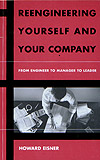 Howard Eisner, DSc ’66, GW Distinguished Research Professor and Professor of Engineering Management and Systems Engineering, helps managers excel as leaders in Reengineering Yourself and Your Company (Artech House, Norwood, Mass., 2000). Eisner takes readers through strategies on how to deal effectively with changes in markets and personnel, growth in your enterprise, team management, and integration. He focuses on unique challenges that are sure to impact high-tech companies in the 21st century. Howard Eisner, DSc ’66, GW Distinguished Research Professor and Professor of Engineering Management and Systems Engineering, helps managers excel as leaders in Reengineering Yourself and Your Company (Artech House, Norwood, Mass., 2000). Eisner takes readers through strategies on how to deal effectively with changes in markets and personnel, growth in your enterprise, team management, and integration. He focuses on unique challenges that are sure to impact high-tech companies in the 21st century.
Anyone who is interested in losing weight and keeping it off will want to check out Fabulous Lo-Carb Cuisine (Light Street Press, Columbia, Md., 2000), the latest offering from award-winning cookbook author Ruth Glick, BA ’64. “Until a few years ago, I was convinced that low fat was the way to go. When it became impossible for me to lose weight on a low fat diet, I decided to try a low-carb approach. It worked wonders for me and my husband. We’ve both lost about 20 pounds and kept it off for a year and a half.” Fabulous Lo-Carb Cuisine includes more than 100 great tasting and easy to prepare dishes. Glick’s book 100 Percent Pleasure was named one of the “12 Best Cookbooks of 1994.” She also has been the recipient of a National Health Information Bronze Award from the Health Resource Center.
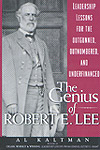 Nearly a century and a half after his defeat, Robert E. Lee remains an American icon, ranking with Wash-ington and Lincoln as one of the country’s most admired and respected historical figures. Management consultant Al Kaltman, PhD ’70, spotlights the organizational genius of the general, who left behind a lasting legacy of integrity, strategic vision, and leadership charisma in The Genius of Robert E. Lee: Leadership Lessons for the Outgunned, Outnumbered, and Underfinanced (Prentice Hall Press, Paramus, N.J. 2001). Using vignettes from the general’s life and career—before, during, and after the war—Kaltman condenses Lee’s management brilliance to 260 strategies for success in the modern business world. Nearly a century and a half after his defeat, Robert E. Lee remains an American icon, ranking with Wash-ington and Lincoln as one of the country’s most admired and respected historical figures. Management consultant Al Kaltman, PhD ’70, spotlights the organizational genius of the general, who left behind a lasting legacy of integrity, strategic vision, and leadership charisma in The Genius of Robert E. Lee: Leadership Lessons for the Outgunned, Outnumbered, and Underfinanced (Prentice Hall Press, Paramus, N.J. 2001). Using vignettes from the general’s life and career—before, during, and after the war—Kaltman condenses Lee’s management brilliance to 260 strategies for success in the modern business world.
“Everything you need to know to make money in the markets can be found in the Bible,” according a Sept. 29, 2000, article in The Wall Street Journal. Long-time Wall Street broker Ron Peterson, Att ’63, explains how in his new book, Solomon’s Riches—A Biblical Guide to Your Investments and Wealth (X Libris, Philadelphia, 2000).
William Hurt or William Shakespeare? Paper or plastic? Diet or exercise? Arthur Schechter, BA ’81, and Paula Schechter present 1,800 conversation-starting questions spanning pop culture, history, politics, science, music, and sports in their new book, Or: Is It a Game or Is It Life? (Andrews McMeel Publishing, Kansas City, Mo., 2000).
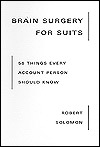 Veteran account manager Robert Solomon, BA ’72, reveals the tricks of his trade in Brain Surgery for Suits: 56 Things Every Account Person Should Know (Strategy Press, New York, 2000). The fast-reading book outlines ways to build better client relationships, develop more precise strategy briefs, run more productive meetings, and improve the creative product. Solomon recently founded Solomon Strategic, which provides marketing counsel to both agencies and client companies. His second book, Rocket Science for Clients, will be published later this year. Veteran account manager Robert Solomon, BA ’72, reveals the tricks of his trade in Brain Surgery for Suits: 56 Things Every Account Person Should Know (Strategy Press, New York, 2000). The fast-reading book outlines ways to build better client relationships, develop more precise strategy briefs, run more productive meetings, and improve the creative product. Solomon recently founded Solomon Strategic, which provides marketing counsel to both agencies and client companies. His second book, Rocket Science for Clients, will be published later this year.
GW Emeritus Professor of Economics Charles T. Stewart Jr., BA ’46, MA ’48, PhD ’54, transforms his 50-year avocation of writing poetry into a rich commentary on nature, travel, and culture in Around the World in Eighty Years: A Collection of Poems (Brunswick Publishing Corp., Lawrenceville, Va., 2000).
Bridges were one of the major symbols of our country’s Civil War, according to experienced engineer historian Phillip M. Thienel, BA ’48, in Mr. Lincoln’s Bridge Builders: The Right Hand of American Genius (White Mane Books, Shippensburg, Pa., 2000). The bridges at Bull Run, Fredericksburg, Vicksburg, and on the James River are just a few of the engineering efforts analyzed in the book, which helps students of Civil War strategy and tactics better understand how the Northern armies were able to maneuver and fight as they did.
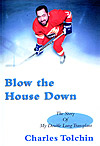 What it is like to receive a life-saving organ transplant? Cystic fibrosis patient Charles Tolchin, BBA ’92, details the story of his 1997 double lung transplant in Blow the House Down (Writers Club Press, Lincoln, Neb., 2000). An avid skier, ice hockey player and weight lifter, Tolchin works in advertising for Ogilvy Interactive, a division of Ogilvy & Mather. What it is like to receive a life-saving organ transplant? Cystic fibrosis patient Charles Tolchin, BBA ’92, details the story of his 1997 double lung transplant in Blow the House Down (Writers Club Press, Lincoln, Neb., 2000). An avid skier, ice hockey player and weight lifter, Tolchin works in advertising for Ogilvy Interactive, a division of Ogilvy & Mather.
Fans of baseball and poetry will undoubtedly enjoy The Lives of the Two-Headed Baseball Siren (Kings Estate Press, Northport, N.Y., 2001), by Frank Van Zant, BA ’83. The book is Van Zant’s second collection of published poems.
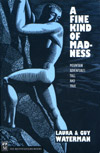 Prior to his untimely, tragic death, Guy Waterman, BA ’53, co-wrote with his wife, Laura, A Fine Kind of Madness (The Mountain Mountaineers Books, Seattle, 2000). The book was inspired by the experiences of a life of climbing and concern for the environment that the Watermans shared for almost 30 years. Laura and her late husband are also the authors of four other books: Forest and Crag, Yankee Rock and Ice, Wilderness Ethics, and Backwoods Ethics. Prior to his untimely, tragic death, Guy Waterman, BA ’53, co-wrote with his wife, Laura, A Fine Kind of Madness (The Mountain Mountaineers Books, Seattle, 2000). The book was inspired by the experiences of a life of climbing and concern for the environment that the Watermans shared for almost 30 years. Laura and her late husband are also the authors of four other books: Forest and Crag, Yankee Rock and Ice, Wilderness Ethics, and Backwoods Ethics.
|